The elf owl is the world’s smallest owl, weighing as little as 35 grams (1.2 ounces) and measuring just 12 centimeters (4.7 inches) in length. Close behind are the long-whiskered owlet and Tamaulipas pygmy owl, two elusive forest species with males as small as 13 centimeters (5.1 inches) and just over 50 grams (1.8 ounces) in weight.
This article explores the smallest owls known to science, focusing on the lightest and shortest individuals recorded in the wild. These miniature raptors thrive in a range of habitats, from cactus-studded deserts to cloud forests and high-altitude woodlands. We examine how their size influences hunting and behavior, how they avoid predation despite their vulnerability, and why these tiny owls deserve close conservation attention.
Elf owl (Micrathene whitneyi)
- Body length: As small as 12 cm (4.7 in).
- Weight: As little as 35 g (1.2 oz).
- Where found: Arid woodlands and desert scrub of the southwestern U.S. and central Mexico.
- Conservation status: Least Concern.
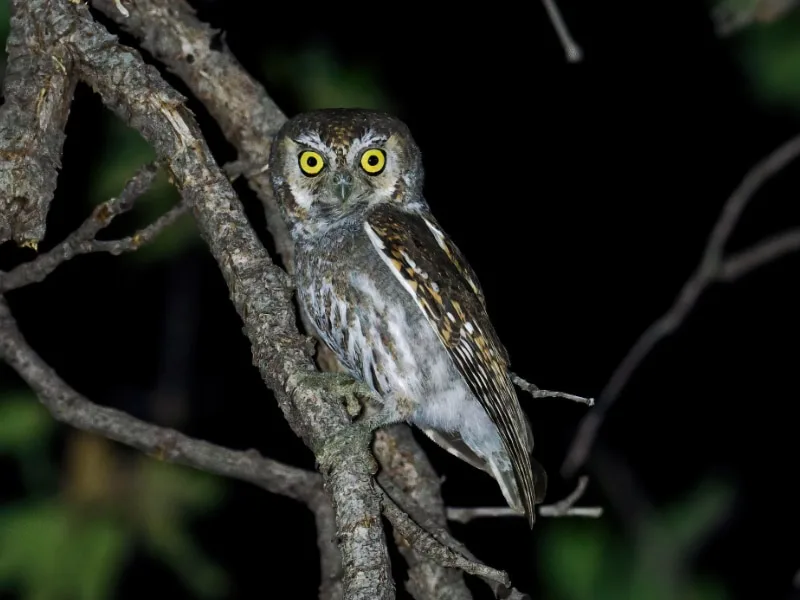
The elf owl is the smallest and lightest owl in the world, and also the tiniest bird of prey across all raptor groups. Measuring down to just 12 centimeters (4.7 inches) in body length and weighing as little as 35 grams (1.2 ounces), it rivals the smallest songbirds in size. With a wingspan of only about 25 centimeters (9.8 inches), this tiny owl is built for agile flight through cactus stands and low woodland. Its soft gray-brown plumage, faint streaks, pale yellow eyes, and narrow white “eyebrows” give it a gentle, inquisitive appearance. It nests in abandoned woodpecker cavities, particularly in saguaro cacti and deciduous trees, and is most active at night, feeding mainly on insects.
The species ranges from central Mexico to the southwestern United States, with migratory populations breeding in states like Arizona and Texas and overwintering further south. Though tiny, the elf owl is fiercely territorial. Males claim nest sites and mates with persistent vocal displays, and both sexes defend their territory. An unusual behavior observed in this species is thanatosis – feigning death when captured. Its population is large and widespread, with no severe declines currently reported. However, habitat degradation, especially in desert ecosystems, remains a long-term concern.
Long-whiskered owlet (Xenoglaux loweryi)
- Body length: As small as 13 cm (5.1 in).
- Weight: Around 46 g (1.6 oz).
- Where found: Cloud forests of northern Peru, especially around Abra Patricia and Cordillera de Colan.
- Conservation status: Vulnerable.

The long-whiskered owlet is a small and elusive owl. Measuring just 13 centimeters (5.1 inches) in length and weighing only 46 grams (1.6 ounces), it inhabits dense cloud forests of northern Peru. Named for its distinctive facial bristles, this tiny owl has a short tail and large eyes adapted for nocturnal life. Long unknown to science beyond a handful of specimens collected after its 1976 discovery, it has since been confirmed at over 11 localities, most notably in the Abra Patricia region. Its preferred habitat consists of humid, moss-laden forests with thick undergrowth and abundant epiphytes at elevations of 1,800-2,600 meters.
Extremely difficult to observe, the species is reluctant to respond to playback and may have limited flight ability, moving through vegetation rather than open air. With fewer than 1,000 mature individuals estimated to remain in the wild, and possibly far fewer, it is among the most threatened owls globally. Although large tracts of suitable forest still exist, much of it remains unprotected and vulnerable to deforestation and climate change. Continued field research and conservation action are essential to prevent the further decline of this elusive forest miniature.
Tamaulipas pygmy owl (Glaucidium sanchezi)
- Body length: As small as 13.5 cm (5.3 in).
- Weight: Just over 50 g (1.8 oz).
- Where found: Montane cloud forests of northeastern Mexico.
- Conservation status: Near Threatened.
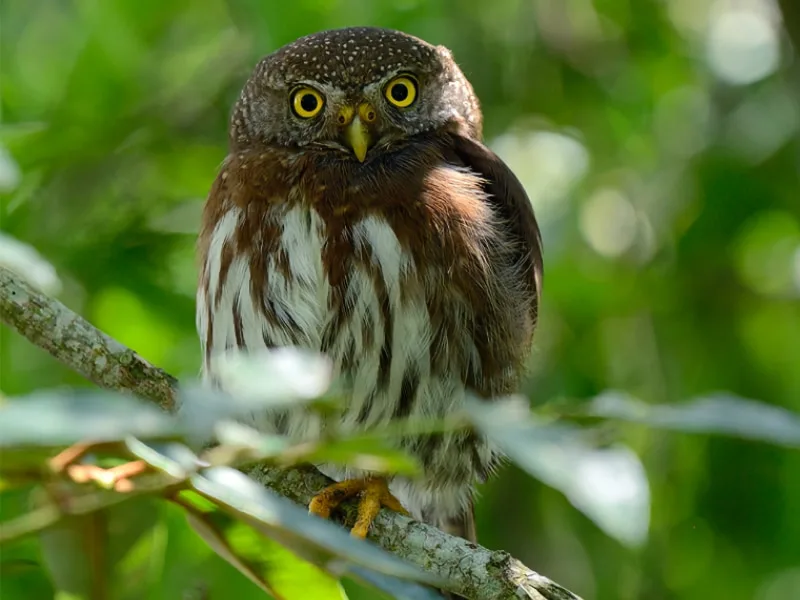
The Tamaulipas pygmy owl is a little-known miniature owl native to the humid montane forests of northeastern Mexico. With a body length of around 13.5 centimeters (5.3 inches) and a weight slightly over 50 grams (1.8 ounces), it’s the lightest members of its genus. This small owl inhabits subtropical evergreen, semi-deciduous, and pine-cloud forest mosaics across a narrow range in the states of Tamaulipas, San Luis Potosi, and Hidalgo. Like many other pygmy owls, it nests in tree cavities, often reusing abandoned woodpecker holes, and is active mainly at dusk and dawn.
Though still regularly observed in parts of its range, the Tamaulipas pygmy owl is considered threatened due to ongoing deforestation and habitat degradation. Logging, even at small scales, continues to fragment the forest and reduce available nesting sites. Its overall population remains poorly known, but with such a restricted distribution and dependence on intact forest, the species is increasingly vulnerable to future decline. Among the smallest of the Glaucidium owls, it remains an important species to monitor within the broader context of threatened Neotropical cloud forest birds.
Eurasian pygmy owl (Glaucidium passerinum)
- Body length: As small as 15 cm (5.9 in).
- Weight: As little as 47 g (1.7 oz).
- Where found: Coniferous and mixed forests from Northern and Central Europe to Siberia.
- Conservation status: Least Concern.
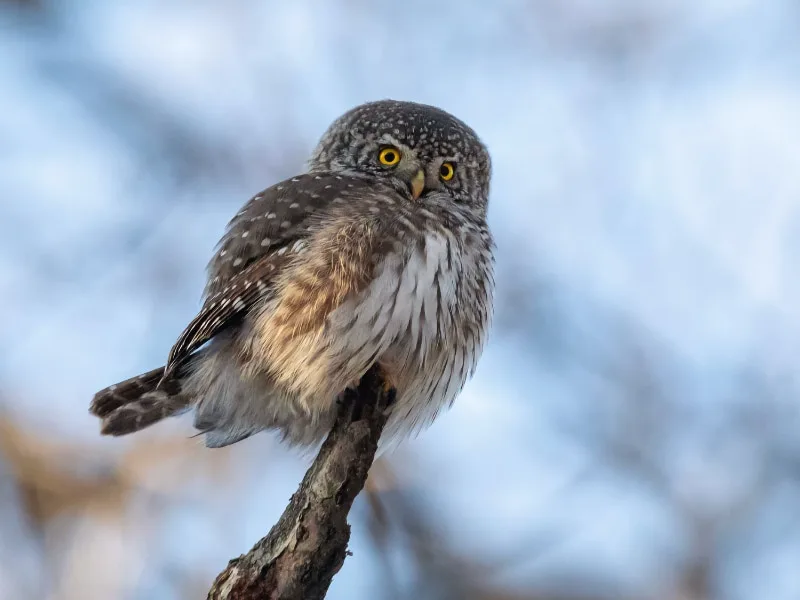
The Eurasian pygmy owl is the smallest owl in Europe and one of the smallest across the Palearctic. Males can weigh as little as 47 grams (1.7 ounces) and measure just 15 centimeters (5.9 inches) in length, making this species a compact yet capable predator. It inhabits mature coniferous and mixed forests across a broad range that stretches from Scandinavia and the Alps through the vast taiga of Siberia. It is most commonly found in forest interiors at mid to high elevations, often nesting in old woodpecker holes or natural tree cavities. Nestboxes are also readily accepted.
This tiny owl is a year-round resident across most of its range, although winter scarcity of prey can trigger some local dispersal. It feeds on small mammals, especially voles, as well as shrews, bats, and small birds, storing excess food in tree cavities during times of plenty. Despite its diminutive size, the Eurasian pygmy owl is fiercely territorial and highly vocal, especially at dawn and dusk during the breeding season. Its population is considered stable and widespread, with no significant threats currently known.
African scops owl (Otus senegalensis)
- Body length: As small as 15 cm (5.9 in).
- Weight: As little as 45 g (1.6 oz).
- Where found: Widespread in wooded habitats across sub-Saharan Africa.
- Conservation status: Least Concern.
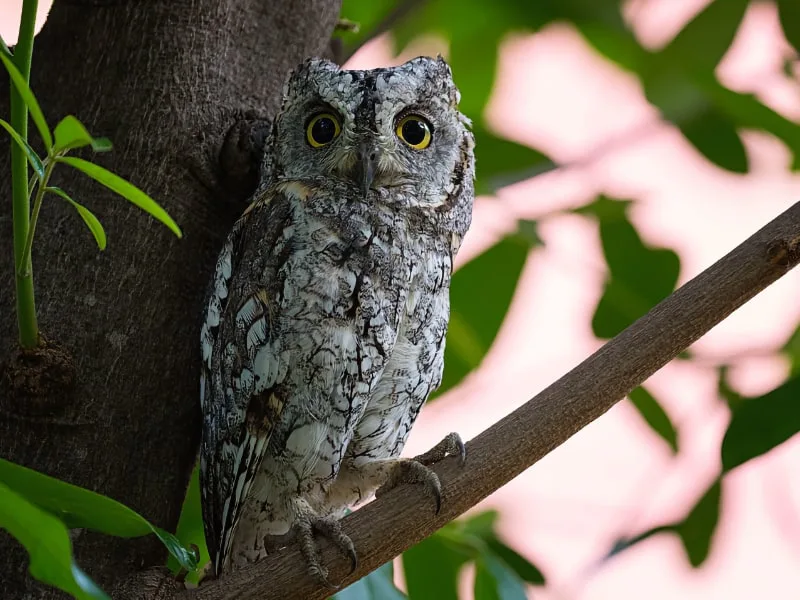
The African scops owl is the smallest owl on the African continent, measuring as little as 15 centimeters (5.9 inches) in length and weighing just 45 grams (1.6 ounces). This tiny owl belongs to the genus Otus, known for its cryptic plumage and compact build. It is widely distributed across sub-Saharan Africa, from lowland savannas and mangroves to forest edges and even urban gardens, showing considerable ecological versatility. It can be found from sea level up to elevations of around 2,000 meters.
Nocturnal and well camouflaged, the African scops owl often goes unnoticed despite being common in many areas. Its call, a distinctive, soft “prreeeuup” note repeated at intervals, is often the only sign of its presence. It nests in tree cavities and feeds on insects and other small invertebrates, typically hunting from low perches. Although its population is believed to be declining slightly due to habitat loss in parts of its range, it remains widespread and adaptable, facing no immediate conservation concerns.
Northern pygmy owl (Glaucidium gnoma)
- Body length: As small as 15 cm (5.9 in).
- Weight: As little as 48 g (1.7 oz) in males.
- Where found: Forested and shrubby habitats from western North America to Central America.
- Conservation status: Least Concern.
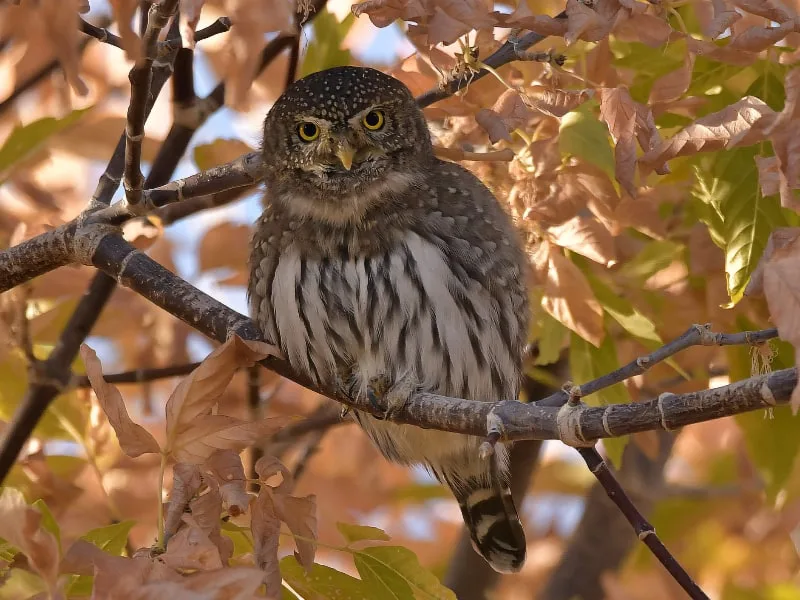
The northern pygmy owl is a compact and assertive species, commonly referred to as the mountain pygmy owl in parts of its range. Males can weigh as little as 48 grams (1.7 ounces) and measure around 15 centimeters (5.9 inches) in length, placing it among the smallest owls in North America. It inhabits a wide variety of wooded habitats, including coniferous forests, oak woodlands, and forest edges, from southern Canada through the western United States and down into Central America. In some regions, it descends to lower elevations during winter months.
Despite its tiny size, the northern pygmy owl is a bold predator. It hunts mainly by day, feeding on insects, small mammals, and birds, often capturing prey nearly its own size. Like many in the genus Glaucidium, it features prominent false eyespots on the nape, a defense thought to confuse or deter potential threats. While individual populations can be local or isolated, the species as a whole is widespread and appears to be increasing in number across much of its range.
Collared owlet (Taenioptynx brodiei)
- Body length: As small as 15 cm (5.9 in).
- Weight: As little as 52 g (1.8 oz) in males.
- Where found: Montane forests across South and Southeast Asia.
- Conservation status: Least Concern.
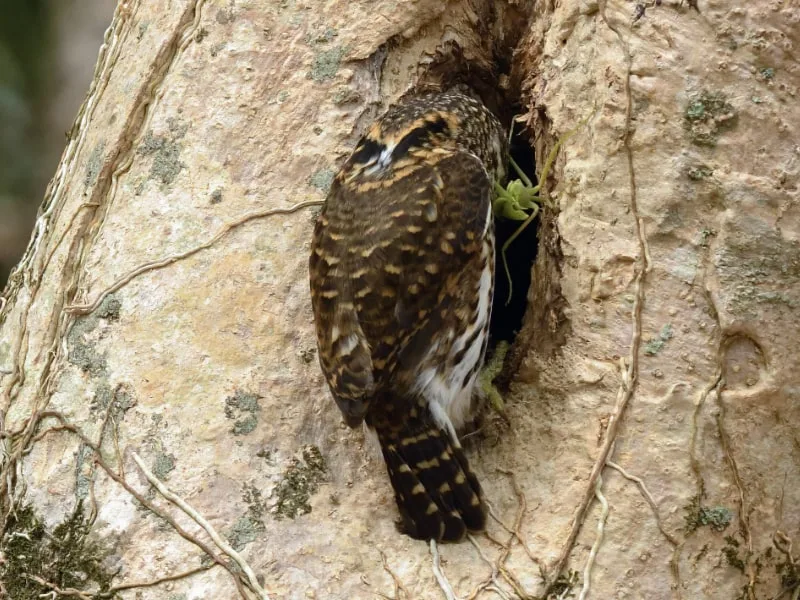
The collared owlet is the smallest owls in Asia, and among the tiniest members of its genus. Measuring approximately 15 centimeters (5.9 inches) in length and with males weighing as little as 52 grams (1.8 ounces), it is a compact predator with an unusually bold demeanor. This diminutive owl is widespread across the montane forests of South and Southeast Asia, ranging from the Himalayan foothills through southern China and across mainland Southeast Asia to Peninsular Malaysia and Taiwan. It typically inhabits elevations between 1,350 and 2,750 meters, though it can be found both higher and lower depending on local conditions.
Unlike most owls, the collared owlet is active during the day and can often be heard and seen in the forest canopy. It preys on insects and occasionally small birds, using surprise and agility to navigate the upper forest layers. Its round head, spotted crown, and bold “false eyes” on the nape (as seen in the photo above) give it a distinctive look. Despite being widespread and locally common, the species is rarely easy to observe due to its small size and arboreal habits.
Ferruginous pygmy owl (Glaucidium brasilianum)
- Body length: As small as 14 cm (5.5 in).
- Weight: As little as 53 g (1.9 oz).
- Where found: From southern Arizona and Texas through Mexico and Central America to much of South America.
- Conservation status: Least Concern.
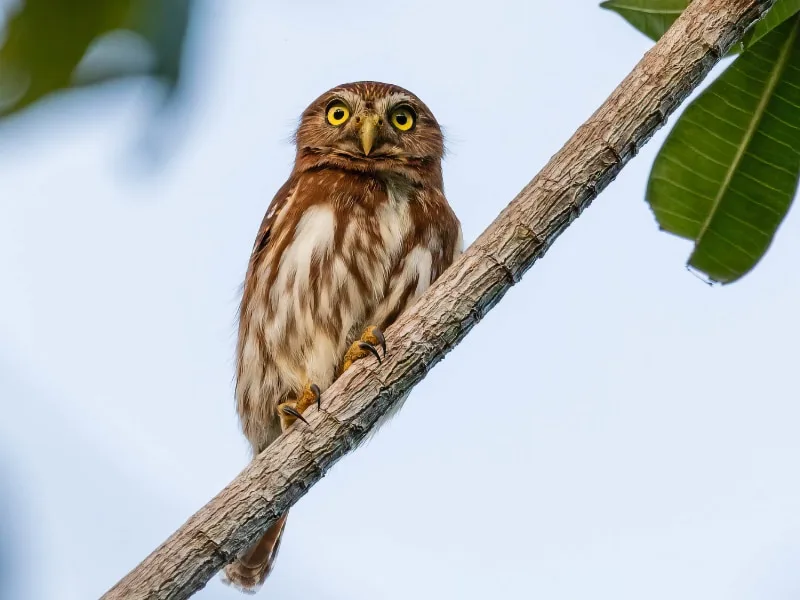
The ferruginous pygmy owl is one of the most widespread and abundant small owls in the Americas. Measuring as little as 14 centimeters (5.5 inches) in length and weighing just 53 grams (1.9 ounces), it is a compact but assertive species found in a variety of wooded and semi-open habitats. Its range extends from the southern United States down through Mexico, Central America, and into South America as far south as Argentina. The species shows a high degree of ecological flexibility, occupying dry forests, thorn scrub, gallery woodlands, and even urban parks.
Despite its size, the ferruginous pygmy owl is a bold hunter, often active during the day. It preys on insects, small reptiles, and even birds, using a swift, direct flight to surprise its prey. Like other members of Glaucidium, it has false eyespots on the back of the head, a defensive feature likely meant to confuse predators. While its overall population is slowly declining due to habitat alteration, it remains one of the most numerous owl species in the Neotropics and is not currently considered at risk.
Why these owls matter
Though small in stature, these owls play a vital role in the ecosystems they inhabit, as predators of insects, rodents, and small birds, and as indicators of forest health and balance. Their small size makes them both specialized and elusive, and some rank among the rarest owls in the world. For species like the long-whiskered owlet and Tamaulipas pygmy owl, continued survival depends on focused conservation and habitat protection. Understanding and protecting the smallest owls means safeguarding some of the most delicate branches of the avian tree – species that reflect both evolutionary refinement and ecological fragility. In doing so, we also shine a light on the hidden richness of forests and the quiet urgency of protecting life at its smallest scale.
Further reading
